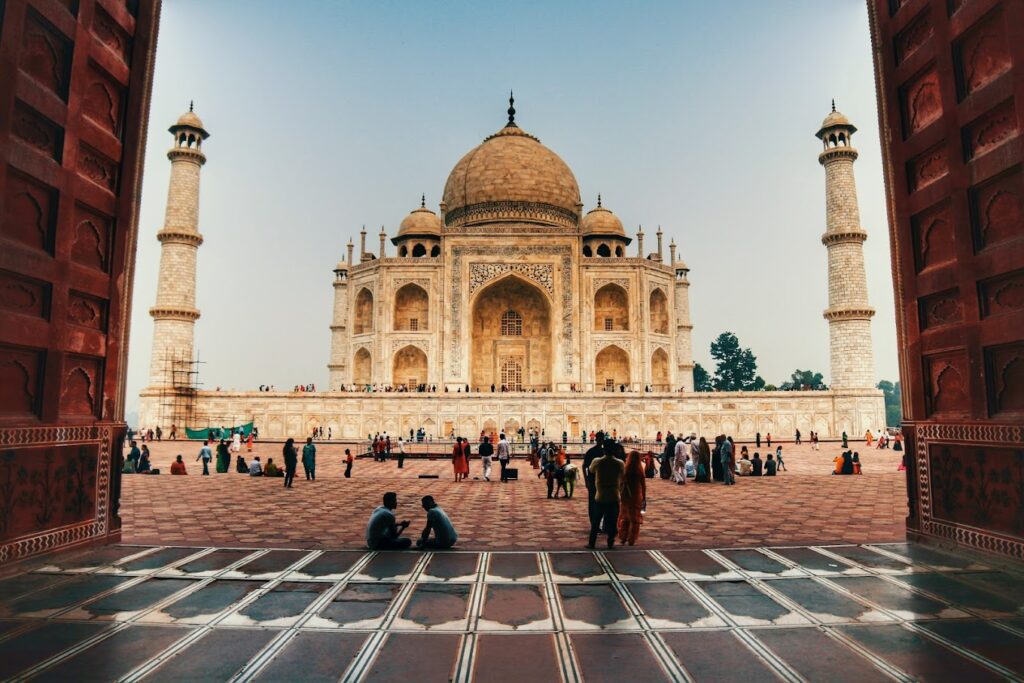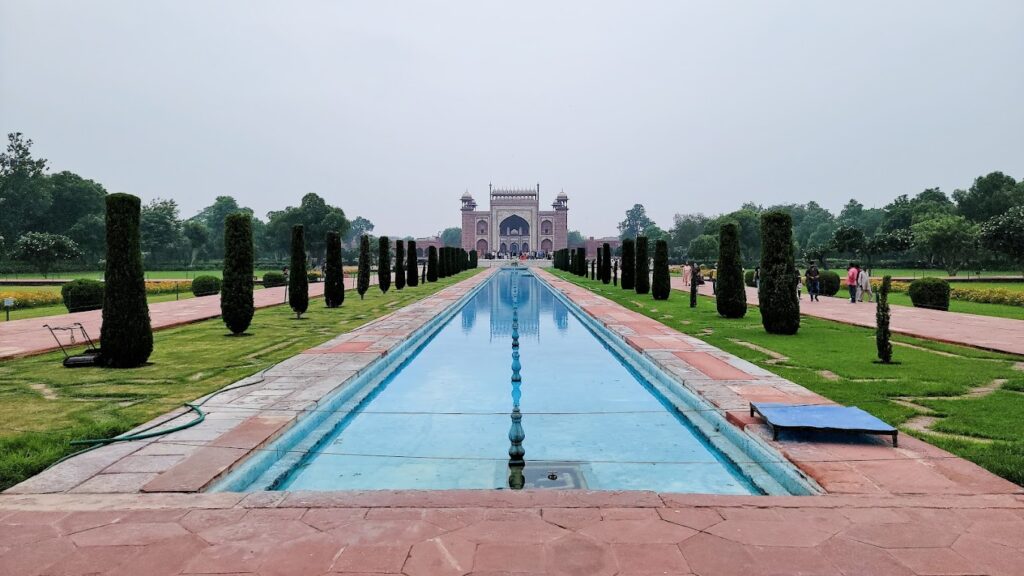
Table of Contents
Taj Mahal: A Timeless Symbol of Love and Architectural Wonder

History and Significance of the Taj Mahal
A Timeless Symbol of Love
The Taj Mahal, one of the world’s most iconic monuments, stands as a testament to eternal love. Commissioned in 1632 by Mughal Emperor Shah Jahan, this architectural masterpiece was built in memory of his beloved wife, Mumtaz Mahal, who passed away while giving birth to their 14th child. The emperor, heartbroken by her loss, envisioned a grand mausoleum that would immortalize their love for centuries to come.
A UNESCO World Heritage Site & Global Wonder
In 1983, the Taj Mahal was designated as a UNESCO World Heritage Site, recognizing its outstanding universal value. It is also one of the New Seven Wonders of the World, drawing millions of visitors each year who come to witness its unparalleled beauty and romantic legacy.
Beyond a Monument: A Cultural & Historical Treasure



The Taj Mahal remains an undying ode to love, artistry, and devotion, standing as one of the most admired and visited landmarks in the world.

Fascinating Facts About the Taj Mahal
The Taj Mahal, one of the most breathtaking architectural wonders in the world, is a symbol of love, beauty, and artistic excellence. Built by Mughal Emperor Shah Jahan in memory of his beloved wife, Mumtaz Mahal, this magnificent white marble mausoleum continues to captivate millions of visitors each year. Beyond its grandeur, the Taj Mahal has several intriguing facts that make it even more remarkable.
1. The Changing Colors of the Taj Mahal
One of the most mesmerizing aspects of the Taj Mahal is its ability to change colors depending on the time of day and lighting conditions:
- Morning: The monument appears to have a soft pinkish hue, reflecting the gentle light of the sunrise.
- Afternoon: Under the bright midday sun, the Taj Mahal shines in a dazzling white.
- Evening: As the sun sets, the marble takes on an orange or golden glow, creating a romantic ambiance.
- Night: During a full moon, the Taj Mahal exudes an ethereal silvery-blue radiance, adding to its mystical charm.
2. The Mystery of the Artisans’ Fate
A long-standing legend suggests that Shah Jahan ordered the hands of the artisans who built the Taj Mahal to be severed or that they were blinded to prevent them from ever creating anything comparable in beauty. While no historical evidence confirms this, the tale adds to the mystique of the monument.
3. UNESCO World Heritage Site & Wonder of the World
- The Taj Mahal was designated a UNESCO World Heritage Site in 1983 due to its unparalleled architectural brilliance and historical importance.
- It was also recognized as one of the New Seven Wonders of the World in 2007, following a global poll.
4. An Engineering Marvel
- The Taj Mahal is built on a wooden foundation, which has remained intact due to the moisture from the nearby Yamuna River.
- The four towering minarets surrounding the mausoleum are slightly tilted outward to ensure they do not fall on the main tomb in the event of an earthquake.
- The intricate calligraphy on the Taj Mahal is an optical illusion—letters appear uniform from a distance, but actually increase in size as they ascend.
5. Precious Stones & Exquisite Artwork
The Taj Mahal was once adorned with over 28 types of precious and semi-precious stones, including:
- Jasper, jade, turquoise, lapis lazuli, sapphire, and onyx, sourced from various parts of Asia.
- Unfortunately, many of these stones were looted by invaders and British colonialists over time.
6. The Black Taj Mahal Myth
- According to legend, Shah Jahan envisioned a black marble replica of the Taj Mahal for his own tomb, situated across the Yamuna River.
- His plan was never realized, as he was overthrown by his son, Aurangzeb.
- Remnants of black marble at Mehtab Bagh lend some credibility to this intriguing theory.
7. Calligraphy and Quranic Inscriptions
- The walls of the Taj Mahal feature exquisite calligraphy from the Quran, masterfully inscribed by Persian calligrapher Amanat Khan.
- A famous inscription above the entrance reads: “O Soul, thou art at rest. Return to the Lord in peace with Him, and He at peace with you.”
8. Protection During Wars
- The Taj Mahal was covered with bamboo scaffolding during World War II and the Indo-Pakistani wars to camouflage it from enemy bombers.
- To preserve its pristine beauty, the monument undergoes mud-pack therapy, a technique used to remove yellowing caused by pollution.
9. The Symbolism of Perfect Symmetry
- The Taj Mahal is a masterpiece of symmetry, with its gardens, pools, and pathways reflecting perfect balance.
- However, the only asymmetrical element is Shah Jahan’s own tomb, which was placed beside Mumtaz Mahal’s, disrupting the otherwise flawless design.
10. A Romantic Destination: The Taj Mahal’s Everlasting Charm
The Taj Mahal is not just an architectural masterpiece; it is a symbol of eternal love, making it one of the most romantic destinations in the world. With approximately 7-8 million visitors annually, this iconic monument draws people from across the globe who come to admire its beauty, history, and the heartfelt love story that inspired its creation.
For centuries, the Taj Mahal has served as a muse for poets, artists, and writers, who have immortalized its grandeur and emotional depth in their works. Its story of unwavering love and devotion has captivated romantics worldwide, earning it a special place in the hearts of couples, honeymooners, and dreamers.
Many visitors, especially newlyweds and couples, consider the Taj Mahal the perfect backdrop for a romantic getaway. Walking hand-in-hand through its lush Mughal gardens, witnessing the play of light on the pristine marble, and experiencing the serene reflection in the Yamuna River create an unforgettable and magical experience.
Whether it’s a moonlit visit, a sunrise tour, or simply soaking in its mesmerizing beauty, the Taj Mahal continues to be a timeless symbol of love and romance, inspiring generations to cherish and celebrate love in its purest form.

Best Time to Visit the Taj Mahal
Ideal Season for a Taj Mahal Trip
The best time to visit the Taj Mahal is from October to March, when the weather is cooler and more comfortable for sightseeing. During these months, the temperatures range between 8°C and 25°C, making it pleasant to explore the monument and its surrounding gardens without the discomfort of extreme heat.



Best Time of the Day to Visit
The magic of the Taj Mahal changes with the sunlight, offering different experiences at different times of the day.



Pro Tips for an Amazing Visit



No matter when you visit, the Taj Mahal’s beauty remains timeless—each time of the day and season adds its own unique charm!
Preservation and Conservation of the Taj Mahal
The Taj Mahal, one of the most treasured architectural masterpieces in the world, faces constant threats from pollution, environmental degradation, and human activity. Over the years, the Indian government, along with UNESCO and other organizations, has implemented various preservation and restoration efforts to safeguard this iconic monument for future generations.
Major Threats to the Taj Mahal
-
Air Pollution & Acid Rain
- Industrial emissions, vehicular pollution, and smoke from nearby factories have caused discoloration of the white marble, turning it yellowish over time.
- The pollutants in the air combine with moisture, leading to acid rain, which erodes the monument’s surface.
-
River Yamuna’s Depleting Water Levels
- The foundation of the Taj Mahal relies on moisture from the Yamuna River to maintain the wooden base beneath the structure.
- A decline in the river’s water levels due to pollution and urbanization poses a risk to the stability of the monument.
-
Tourism & Human Impact
- The Taj Mahal attracts millions of visitors annually, leading to wear and tear of the marble flooring and excessive foot traffic.
- Carbon dioxide emissions from human breath inside the mausoleum have contributed to surface degradation over time.
Government & International Conservation Efforts
-
Restricting Vehicular Emissions
- The Taj Trapezium Zone (TTZ), a 10,400 sq. km eco-sensitive area, was established around the Taj Mahal to limit industrial and vehicular pollution.
- Petrol and diesel vehicles are banned within 500 meters of the monument, and visitors must use battery-operated vehicles, bicycles, or walk to reach the site.
-
Closure & Relocation of Polluting Industries
- In 1996, the Supreme Court of India ordered the closure or relocation of polluting industries near the Taj Mahal, including those emitting sulfur dioxide and carbon-based pollutants.
-
Regular Cleaning & Marble Protection
- The Archaeological Survey of India (ASI) periodically cleans the Taj Mahal’s marble surfaces using “Multani Mitti” (Fuller’s Earth), a traditional clay treatment that absorbs dirt and pollutants.
- Special cleaning solutions and laser technology are also used to remove black spots and discoloration from the marble.
-
Preservation of the Yamuna River
- Government initiatives focus on cleaning the Yamuna River, restoring its water levels, and preventing sewage and industrial waste from being dumped into it.
- Plans for afforestation around the riverbanks aim to reduce soil erosion and improve environmental conditions.
-
Tourism Management & Visitor Regulations
- Entry is restricted to a limited number of daily visitors to reduce overcrowding.
- Footwear covers are provided to tourists entering the mausoleum to prevent marble damage.
- Authorities have set strict rules against touching or defacing the monument, with heavy fines for violations.
-
Lighting & Security Measures
- To prevent damage from excessive artificial lighting, the Taj Mahal is not illuminated at night, except on full moon nights and for special occasions.
- Advanced CCTV surveillance and security personnel ensure that visitors follow conservation guidelines.
Future Conservation Initiatives
- Advanced air filtration systems are being explored to improve air quality in the Taj Mahal’s vicinity.
- Bio-diversification programs aim to plant more trees in the Taj Nature Walk area to act as a natural pollution filter.
- Research is being conducted to develop nano-coating technology to protect the marble from pollution damage while maintaining its natural beauty.
Conclusion
The Taj Mahal is more than just an architectural wonder—it stands as a timeless symbol of love, devotion, and artistic brilliance. This magnificent structure not only showcases the grandeur of Mughal architecture but also reflects the depth of emperor Shah Jahan’s love for Mumtaz Mahal, immortalized in white marble. With its intricate carvings, stunning symmetry, and ethereal beauty that changes with the light of day, the Taj Mahal continues to captivate millions of visitors from around the world.
Beyond its architectural and artistic splendor, the Taj Mahal is a historical treasure, preserving centuries of India’s rich heritage, craftsmanship, and cultural magnificence. As one of the New Seven Wonders of the World, it stands as an icon of India, drawing tourists, historians, and art lovers who seek to experience its unparalleled charm and serenity.
A visit to the Taj Mahal is more than just sightseeing—it is a journey into history, a moment of admiration for human ingenuity, and an opportunity to witness a love story etched in stone. Whether you come as an admirer of art, history, or romance, the Taj Mahal promises an unforgettable experience, leaving every visitor with a sense of wonder, inspiration, and admiration for one of the world’s greatest monuments.
For More Info You Can Visit Here .
Want to read more articles like this? Explore now!

